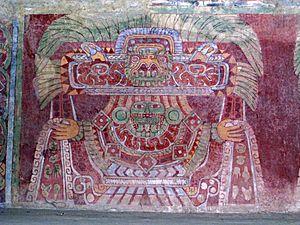Great Goddess of Teotihuacan facts for kids
The Great Goddess of Teotihuacan (also called the Teotihuacan Spider Woman) is a powerful goddess from the ancient Teotihuacan civilization. This civilization existed in what is now Mexico from about 100 BCE to 700 CE, long before Christopher Columbus arrived. She is often seen in the amazing murals found in the ancient city of Teotihuacan.
Contents
Who Was the Great Goddess?
The Great Goddess is easy to spot in ancient artwork. She often wears a special bird headdress, which might show an owl or a quetzal bird. She also has a unique nose pendant with fangs hanging down. These fangs usually curl outwards, with a middle one pointing down.
What She Looked Like
You'll often see her wearing beautiful jewelry, like beaded necklaces and earrings. These were popular among women in Teotihuacan. Her face is always shown from the front, sometimes masked or partly covered. Her hands are usually stretched out, as if she is giving gifts. These gifts often include water, seeds, and precious jade treasures. The colors red and yellow are also often used to show her.
Murals and Meanings
In some murals, like those at Tepantitla, the Great Goddess has plants growing from her head. Spiders and butterflies are sometimes seen on these plants. Water drips from the branches and flows from her hands. This shows her connection to water and nature.
Below one famous mural of the Great Goddess, there's a scene with many small human figures. They are often shown swimming in rivers or playing. This scene might represent a paradise or a special place connected to the goddess. It shows how important she was to the people of Teotihuacan.
What Was Her Domain?
The Great Goddess was believed to control many important things. She was connected to the underworld, darkness, the earth, and water. She might have also been a goddess of war and even creation itself.
Animals and Symbols
Animals like the jaguar, owl, and especially the spider were linked to darkness in ancient Mesoamerican cultures. They were often found in caves or seen at night. The Great Goddess is often shown with these creatures, which supports her connection to the underworld.
Many murals show spiders in the background, on her clothes, or hanging from her arms. She is also sometimes seen with shields decorated with spider webs. This suggests her link to warfare and protection.
Gifts and Paradise
Despite her connections to darkness and war, the Great Goddess is often shown in beautiful, paradise-like settings. She is seen giving gifts, like the water flowing from her hands in the Tepantitla mural. The scene below her portrait shows people swimming, playing, and dancing. This suggests she was also a gentle goddess who brought good things to the world.
Similar Ancient Deities
Some Native American groups, like the Pueblo and Navajo peoples, have stories about a similar deity. She is called the Spider Grandmother. She shares many traits with the Teotihuacan Spider Woman, showing how ancient beliefs can be connected across different cultures.
See also
 In Spanish: Gran Diosa de Teotihuacán para niños
In Spanish: Gran Diosa de Teotihuacán para niños
Images for kids



